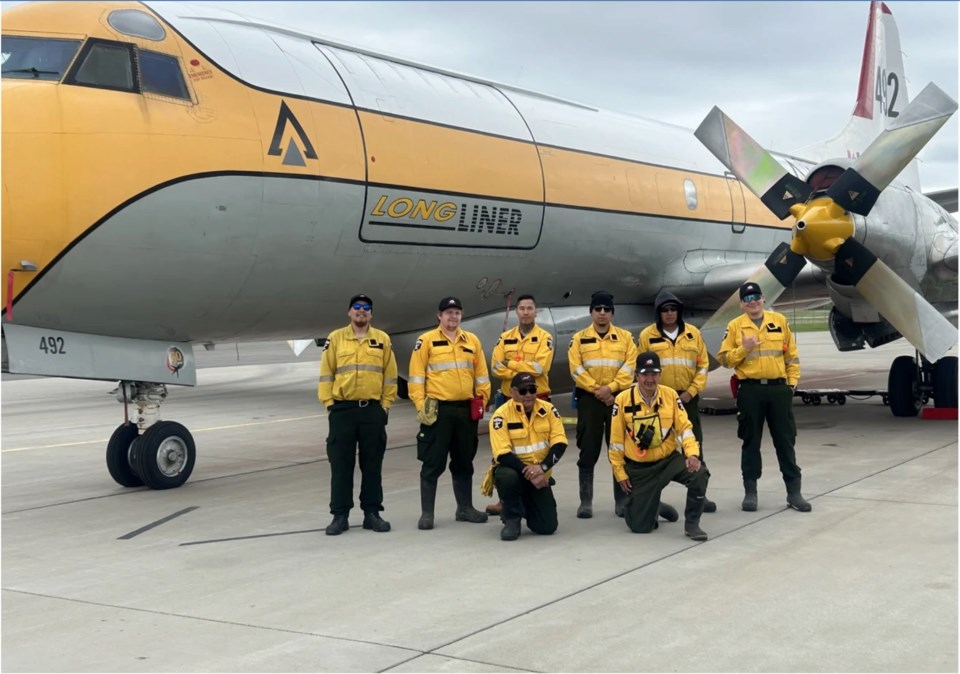LAC LA BICHE - The 13 air tanker bases across the province will be seeing a rotation of firefighting aircraft over the coming weeks coordinated by the Alberta Wildfire Coordination Centre in Edmonton.
Tanker bases are found in and around Alberta communities that include Lac La Biche, Hinton, Slave Lake, Rocky Mountain House, and Springbank near Calgary.
Big air
At the Lac La Biche Air Tanker Base, the tarmac is filling up this week with aircraft to fight the season’s wildfires. One plane in particular takes up more space than others. With a 100-foot wingspan and length from nose to tail of 104 feet, the Electra Lockheed L188 covers a lot of area – whether its sitting on the ground or flying in the air.

This week, as one of Alberta’s nine air tanker groups uses the Lac La Biche tanker base as their home location, the Electra is sharing the tarmac with a group of four AT-802 planes, known as Air Tractors. The tractors are a common sight in southern Alberta. The planes, skimmers, which can land on water bodies to re-fill their water tanks are agile and small enough to find and load water in rugged terrain.
While the Air Tractors are skimmers, able to draw up to 3,100 litres of water in less than 15 seconds, the Electra can carry almost four-times that payload of fire retardant – about 11,365 litres – but must land at a tanker base to have the payload filled and re-filled by ground support crews for each mission.
“The Electra utilizes long-term retardant,” said Colby Lachance, an information officer for the Lac La Biche Forest Area, explaining that water dries up quickly when it is dropped on an active fire, whereas long-term retardant will last longer and acts as a guard to help with fire suppression efforts as it is less likely to evaporate.
The Electra has a crew of two pilots, she continued, and-despite its large size, can move quickly while fighting fires.
“Even though the Electra is bigger than the Air Tractors or CL215 it is much faster in the sky,” Lachance said.
According to Lachance, the Electra has a cruising speed of 555 kilometres per hour, or just over 300 knots. The tractors have a top speed of about 300 kilometres per hour.
While the firefighting aircraft will be stationed at the Lac La Biche airtanker base during the wildfire season, as Lachance explains, none of these planes will be here on a full-time 24/7 basis.
“The group of airtankers and skimmers take turns on rotation around the province and are sent to areas when needed or during high fire danger hazard,” she told Lakeland This Week, adding that the Electra, which is also on a provincial contract, moves around as well.
The scope of a particular fire hazard, she said, determines how long the aircraft will be posted in Lac La Biche at any given time. This can be a week or more depending on the provincial situation.
If there is a wildfire incident outside of the Lac La Biche Forest Area, she explained, the airtankers will travel to that location and engage in firefighting air tactics. If the wildfire danger is higher, they will go to another air tanker base to ensure that the fire can be fought faster compared to an area with lower hazard that is less likely to get a wildfire.
In addition to the Air Tractor and the Electra, the province also utilizes the CL215 airtanker, which is brought in when needed depending on the wildfire situation and hazard. In the past, the fixed-wing aircraft have included the DC-6 and even B-26 aircraft repurposed from previous military action.
Another aircraft found at tanker bases is the ‘bird dog.’ In Lac La Biche, it’s a Cessna 208B, which serves in observational and reconnaissance role in the fight against wildfires. Forestry officers in the plane guide water bombers to the fires and report on the accuracy and effect of the drops.
“This is the plane that the Air Attack Officer flies in to provide information and direction in which areas of the fire the planes should drop on,” Lachance explained.
Other aircraft make the Lac La Biche Airport and other rural airstrips home during busy fire seasons, including contracted helicopters attached with ‘bambi buckets’ that hang below the choppers and can be dunked into water bodies to carry 300 to 1,200 litres of water to a fire.
Coordination of the tanker crews and bases is handled by the Alberta Wildfire Coordination Centre for all of the province’s 10 forest protection areas. The air support contracts run from May to October, and support what is expected to be about 850 Alberta wildland firefighters on the ground.


